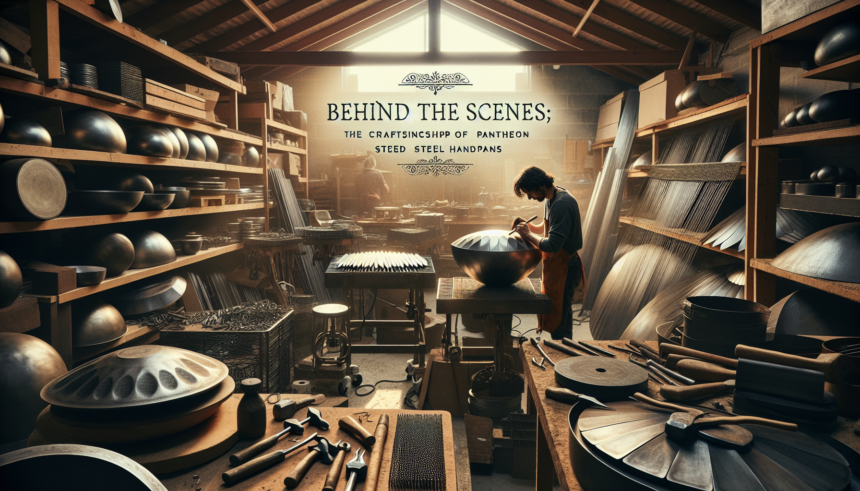The handpan, also known as the hang drum, is an instrument that captures the imagination of musicians and listeners alike. With its ethereal sounds and unique design, it compels curiosity about how it is made. Among the manufacturers of these captivating instruments, Pantheon Steel stands out as a leader in the field. This article delves into the intricate craftsmanship behind Pantheon Steel’s handpans, shedding light on the dedication, precision, and artistry that go into each one.
History and Philosophy
Pantheon Steel was founded by Kyle Cox and Jim Dusin in 2006. Their journey began with a deep admiration for the handpan’s musical possibilities and a desire to develop instruments that could augment this relatively new expressive medium. Driven by a commitment to quality and innovation, Pantheon Steel has since become a revered name in the handpan community.
The philosophy that guides Pantheon Steel is grounded in a profound respect for both the tradition and potential evolution of the handpan. Every creation they produce is an amalgamation of traditional craftsmanship and modern techniques, ensuring not only reliability but also a personalized touch that makes each handpan unique.
The Crafting Process
1. Material Selection
The first step in creating a Pantheon Steel handpan is the selection of high-quality raw materials. At the heart of each handpan are two sheets of nitrided steel. This material is chosen for its exceptional durability and resilience, traits that are crucial in maintaining the instrument’s tonal integrity over time.
The nitriding process itself enhances the steel’s corrosion resistance and hardness, which are essential properties for handpans due to the tension and wear they endure during tuning and playing.
2. Shaping the Shell
Once the steel sheets are prepared, they are carefully shaped into the distinctive dome shape characteristic of handpans. This shaping process requires precision and skill, often beginning with hydroforming or deep drawing techniques to achieve the initial form.
Handcrafting tools are then employed to refine the shape further. This step is crucial, as it sets the foundation for the instrument’s acoustic properties. Any imperfections at this stage can affect the sound quality, so Pantheon Steel craftsmen must exercise meticulous attention to detail.
3. Marking and Placing the Notes
The next phase involves marking the locations of the notes. Each handpan typically features a central note, often referred to as Ding, surrounded by a series of tone fields. The positioning of these notes must be exact to ensure harmonious resonance.
Once marked, these zones are carefully hammered and tuned. This is one of the most delicate parts of the process, requiring a finely tuned ear and an intimate understanding of the metal’s behavior. Each strike must be precise, both in force and location, to achieve the desired pitch and harmonic balance.
4. Fine Tuning and Harmonizing
Following the initial tuning, the handpan undergoes a process of fine-tuning and harmonization. During this stage, craftsmen listen intently to the overtone series produced by each note. Using specialized tools and techniques, they make minute adjustments to ensure that each note sings true and complements the others.
This iterative process involves repeatedly tuning and playing the instrument, adjusting as needed until the perfect harmonic balance is achieved. It’s a laborious and time-consuming task, but one that cannot be rushed if a high-quality instrument is to be produced.
5. Nitriding and Surface Treatment
After the handpan is tuned to satisfaction, it’s often subjected to an additional nitriding process or other surface treatments. These steps further enhance the durability and longevity of the instrument, protecting it from rust and wear.
The surface treatment process also imparts a characteristic color and texture to the handpan, adding to its visual appeal. Each handpan emerges from this stage not only as a musical instrument but as a piece of art, reflecting the unique aesthetics of Pantheon Steel.
6. Final Inspection and Play Testing
The final step in the creation of a Pantheon Steel handpan is a comprehensive inspection and playtesting phase. Each instrument is rigorously tested by skilled musicians to ensure it meets Pantheon Steel’s exacting standards. Only those handpans that pass this stringent quality control process are deemed ready for the market.
Play testing examines both the tactile and auditory responses of the instrument, ensuring that it offers a satisfying playing experience in addition to its pure, resonant sounds.
The Pantheon Steel Difference
What sets Pantheon Steel handpans apart is not just the meticulous craftsmanship but also the ethos that drives their production. Kyle Cox and his team approach each handpan as not merely an instrument but a conduit for artistic expression and emotional connection. This perspective informs every aspect of their work, from material selection through to tuning and playtesting.
Moreover, Pantheon Steel is known for their responsiveness to the needs and preferences of the handpan community. They continually invest in research and development, striving to push the boundaries of what handpans can achieve. This dedication to innovation ensures that Pantheon Steel remains at the forefront of handpan craftsmanship, providing musicians with instruments that inspire and endure.
Conclusion
The crafting of Pantheon Steel handpans is a fusion of art, science, and skill. Each step in the process, from material selection to final tuning, requires a high degree of precision and care. The result is an instrument that offers not only beautiful sounds but also a profound emotional connection for both player and listener.
Through their unwavering commitment to quality and innovation, Pantheon Steel has earned a place of esteem in the handpan world. Their instruments, each one a testament to the craftsmanship and passion of its makers, continue to enchant musicians and audiences around the globe.
FAQs
1. How long does it take to make a Pantheon Steel handpan?
The process of creating a Pantheon Steel handpan is intricate and time-consuming, often taking several weeks. Each step, from shaping the shell to final tuning, requires precision and care that cannot be rushed.
2. What materials are used in Pantheon Steel handpans?
Pantheon Steel handpans are crafted from high-quality nitrided steel. This material is chosen for its durability, resilience, and ability to produce clear, resonant tones.
3. Can I customize my Pantheon Steel handpan?
While Pantheon Steel offers a range of scales and designs, customization options may be limited due to the precise nature of the crafting process. It is best to contact them directly for specific inquiries about custom requests.
4. How should I care for my Pantheon Steel handpan?
Proper care involves regularly cleaning the handpan with a soft cloth and occasionally applying a light layer of oil to prevent rust. It’s also essential to keep the instrument in a stable environment and avoid exposing it to extreme temperatures or humidity.
5. What makes Pantheon Steel handpans unique?
Pantheon Steel handpans are distinguished by their meticulous craftsmanship, high-quality materials, and innovative design. The dedication of their makers to both tradition and innovation ensures that each handpan offers exceptional sound and artistic value.





